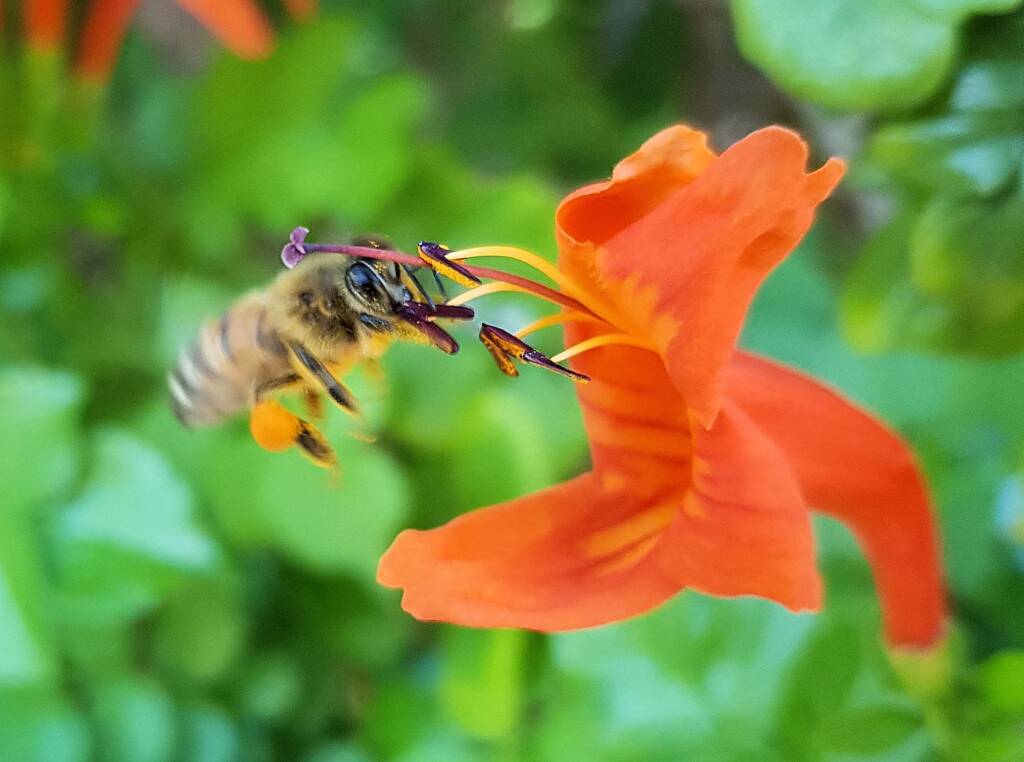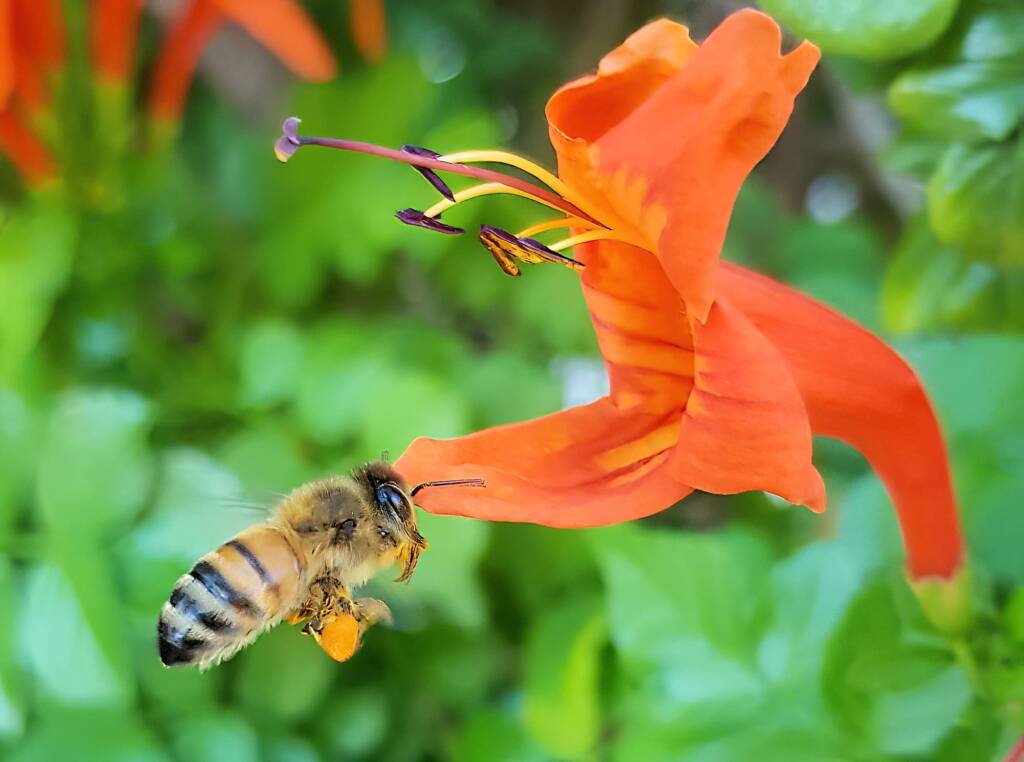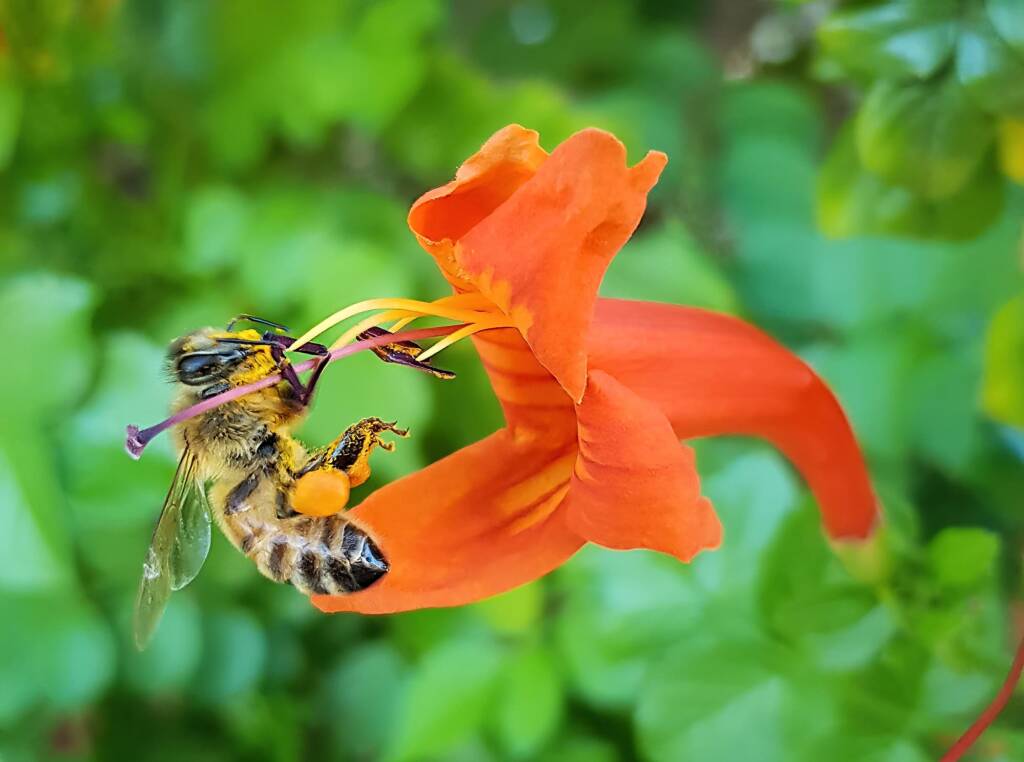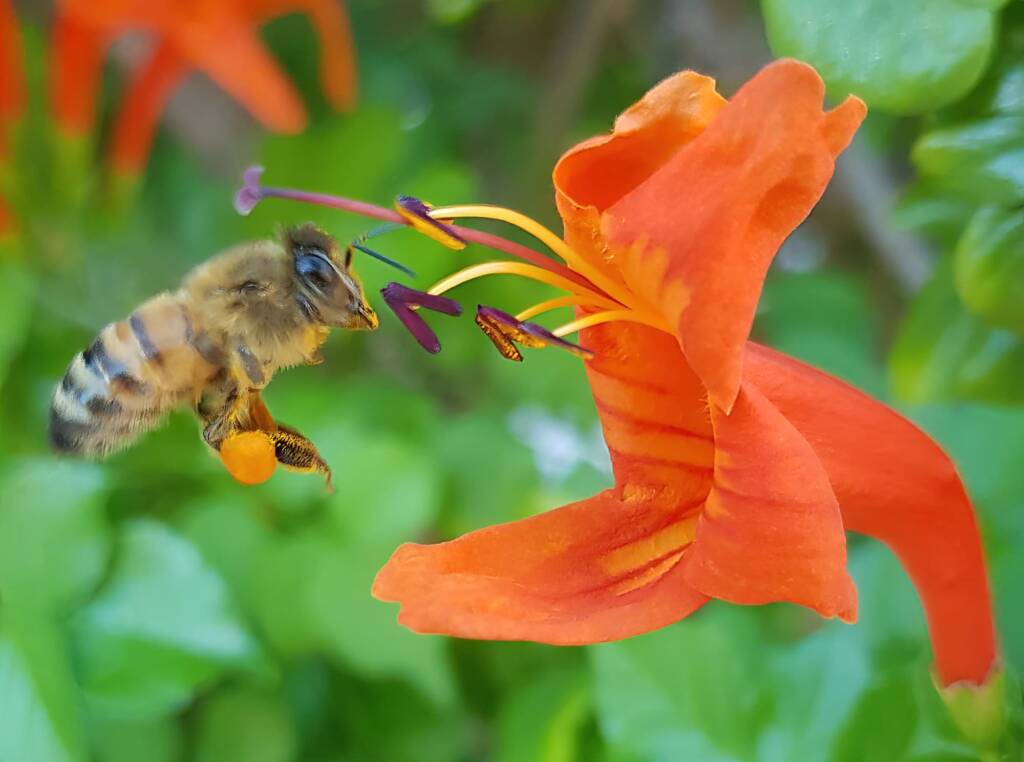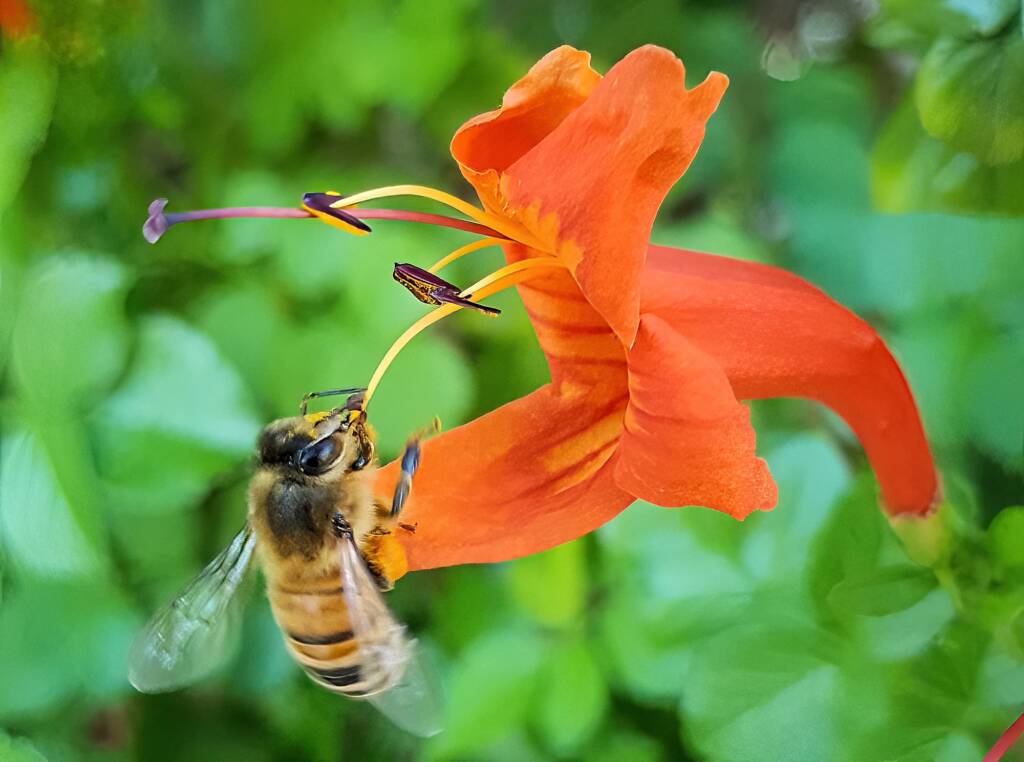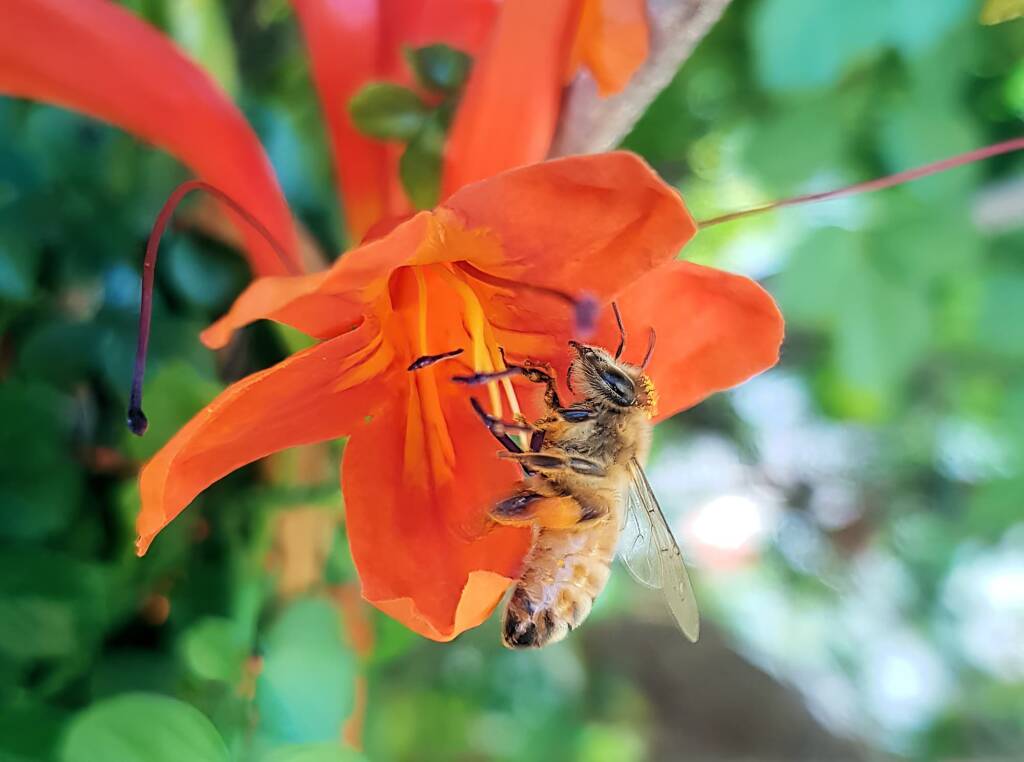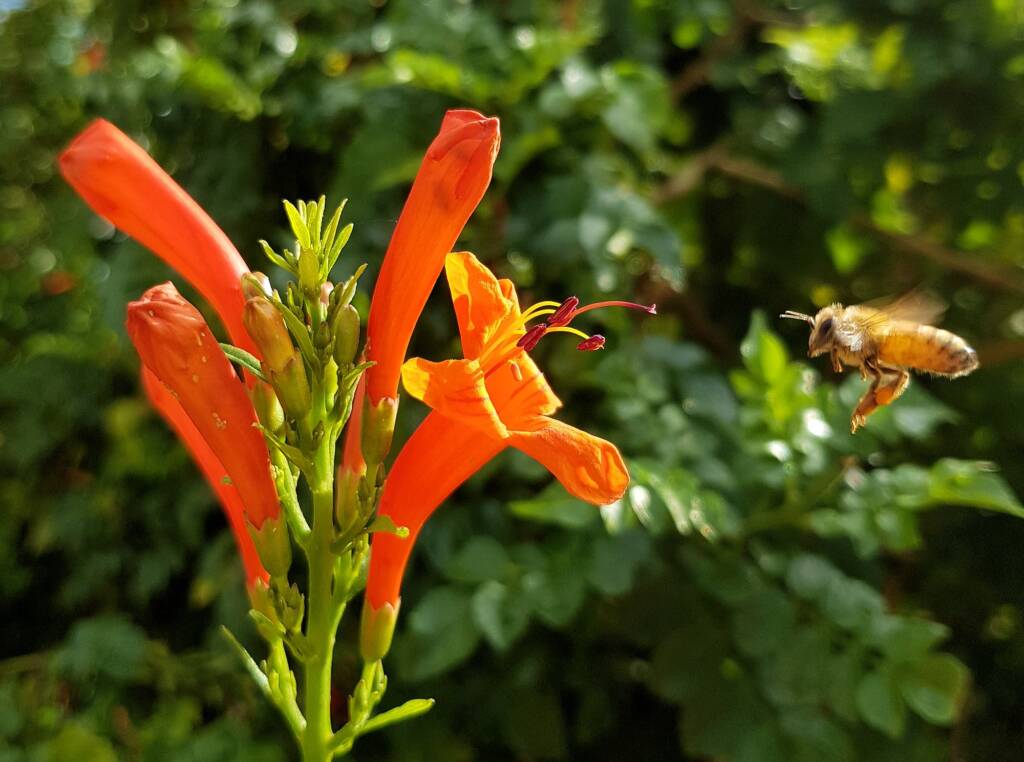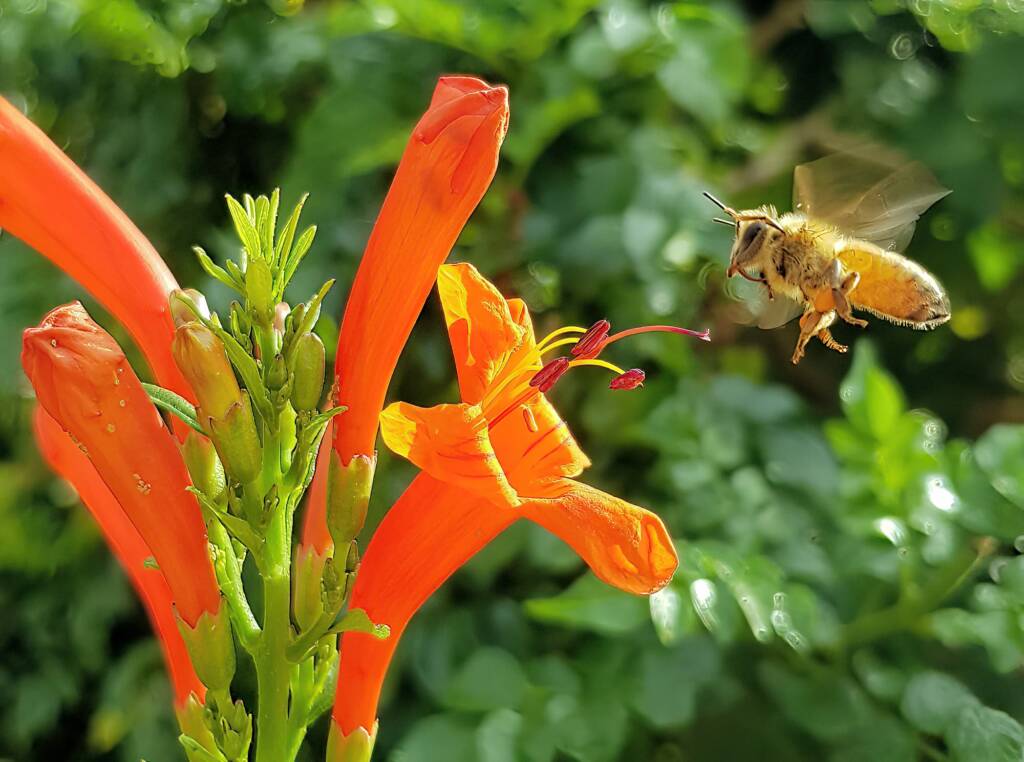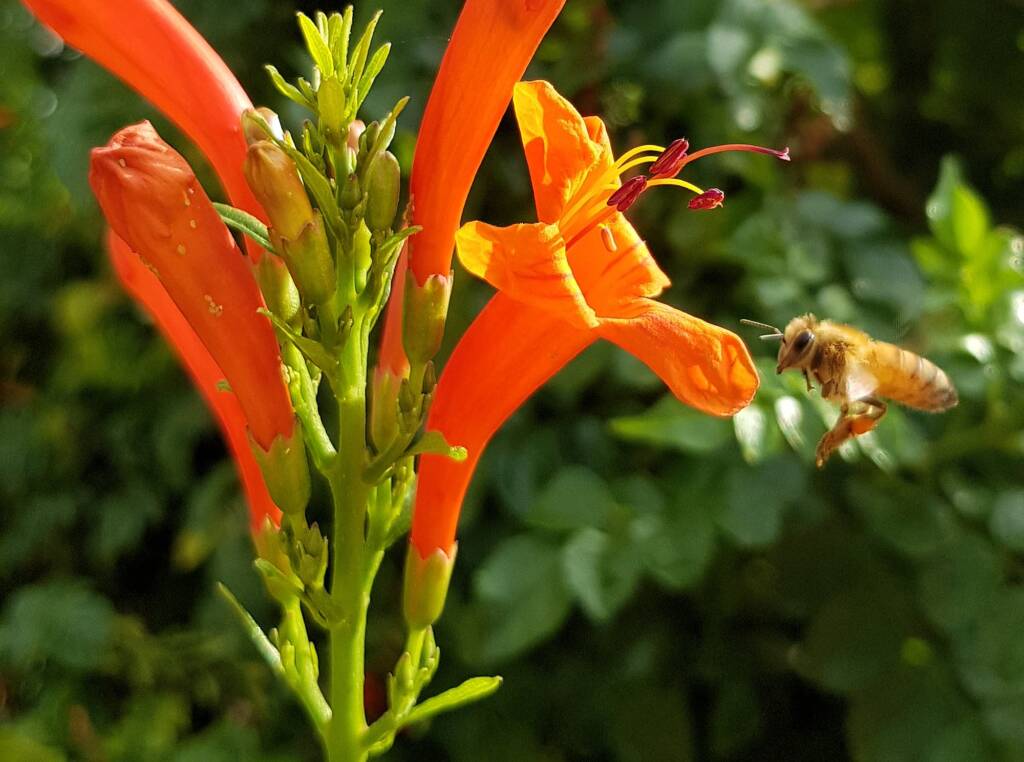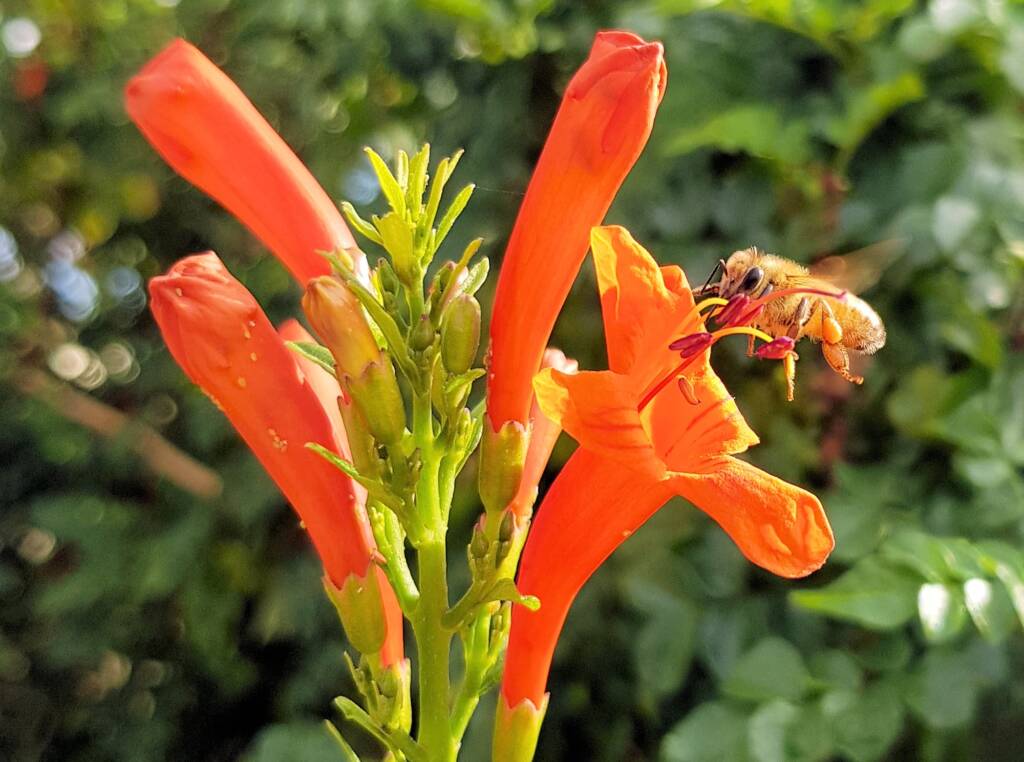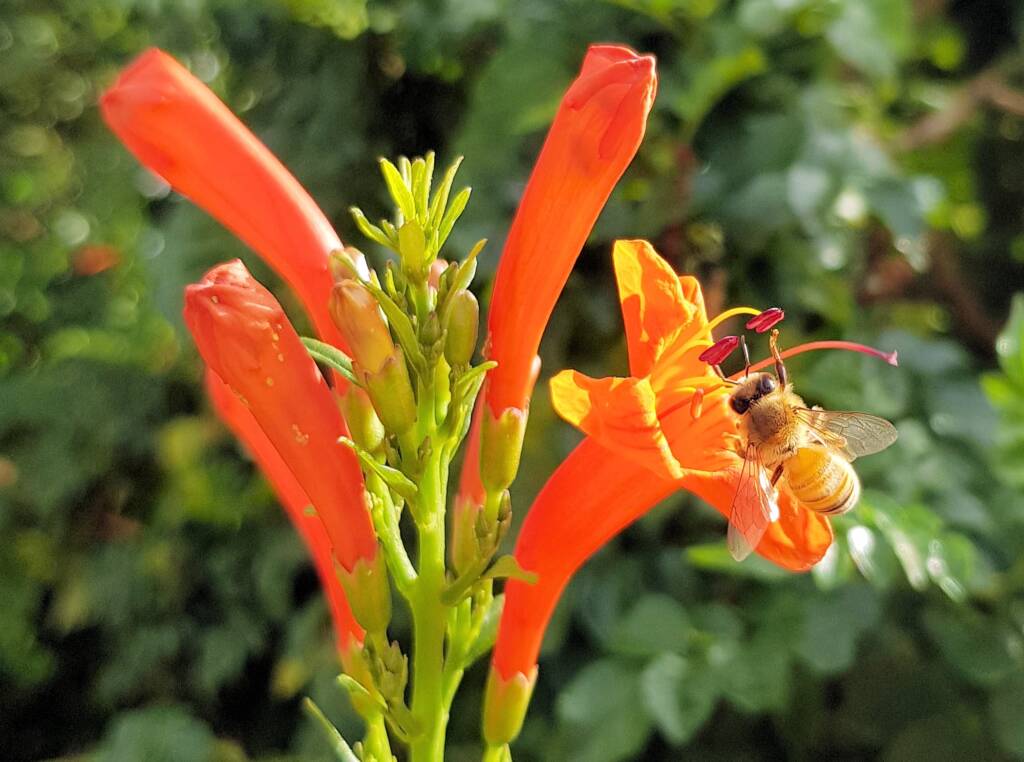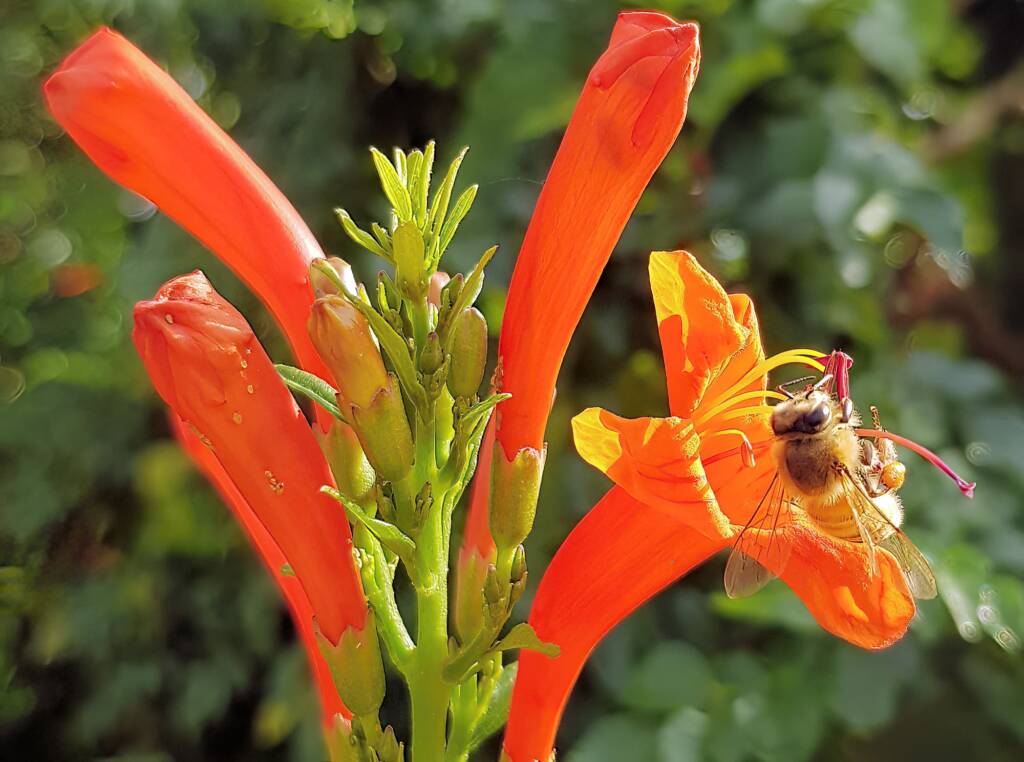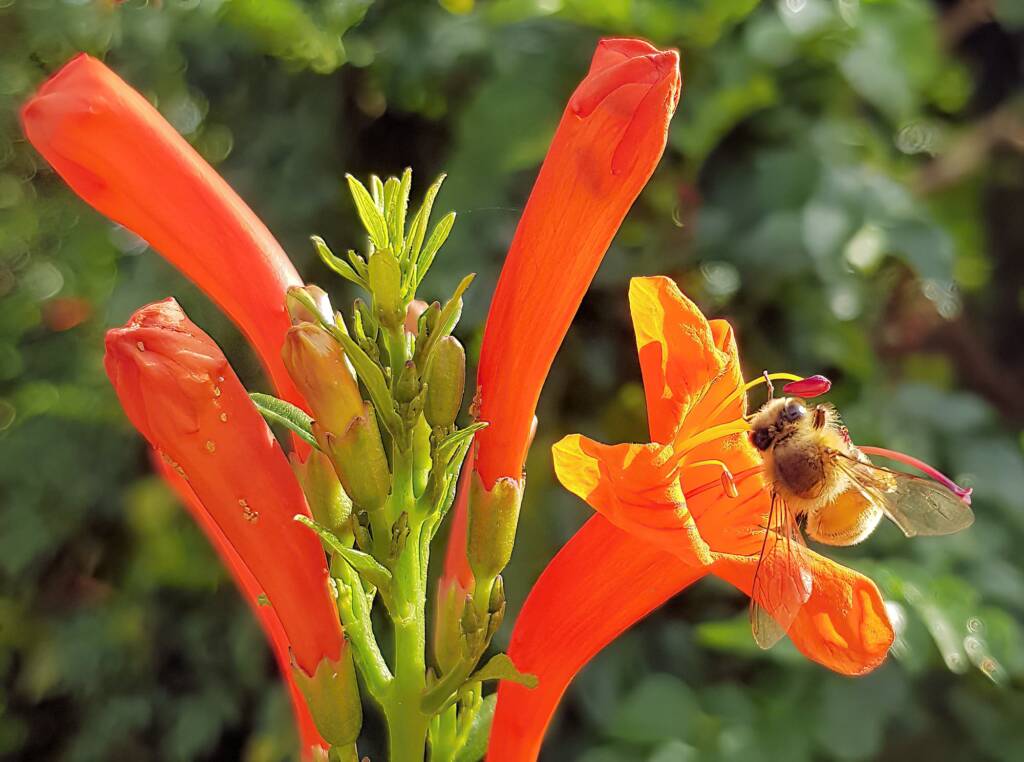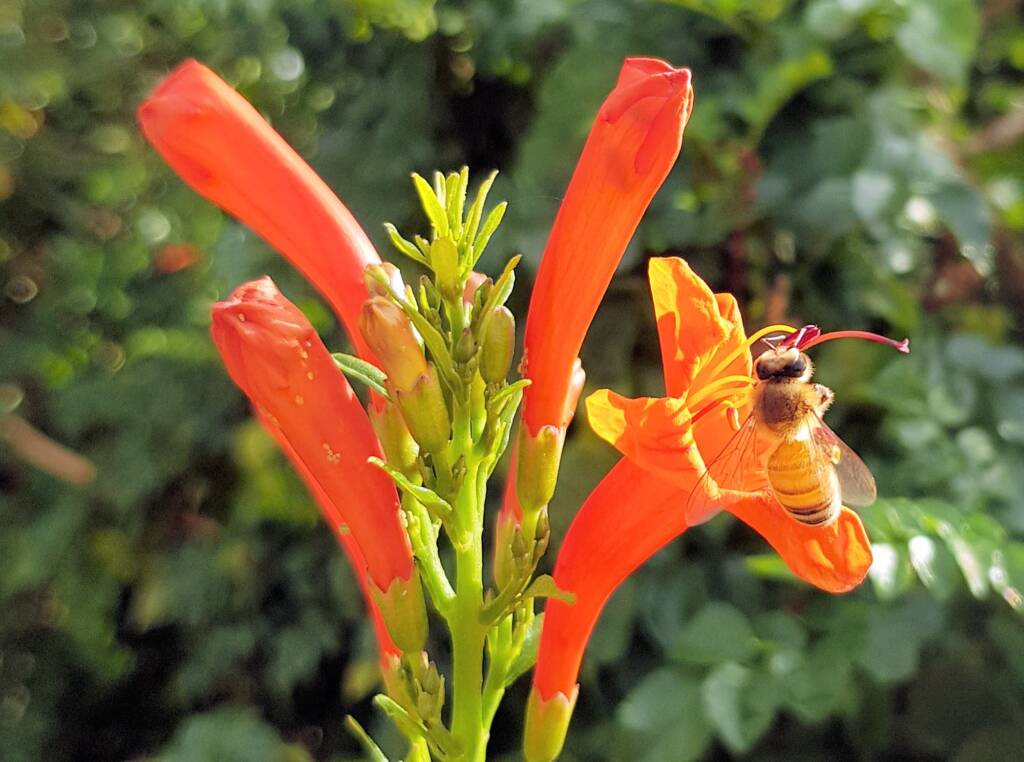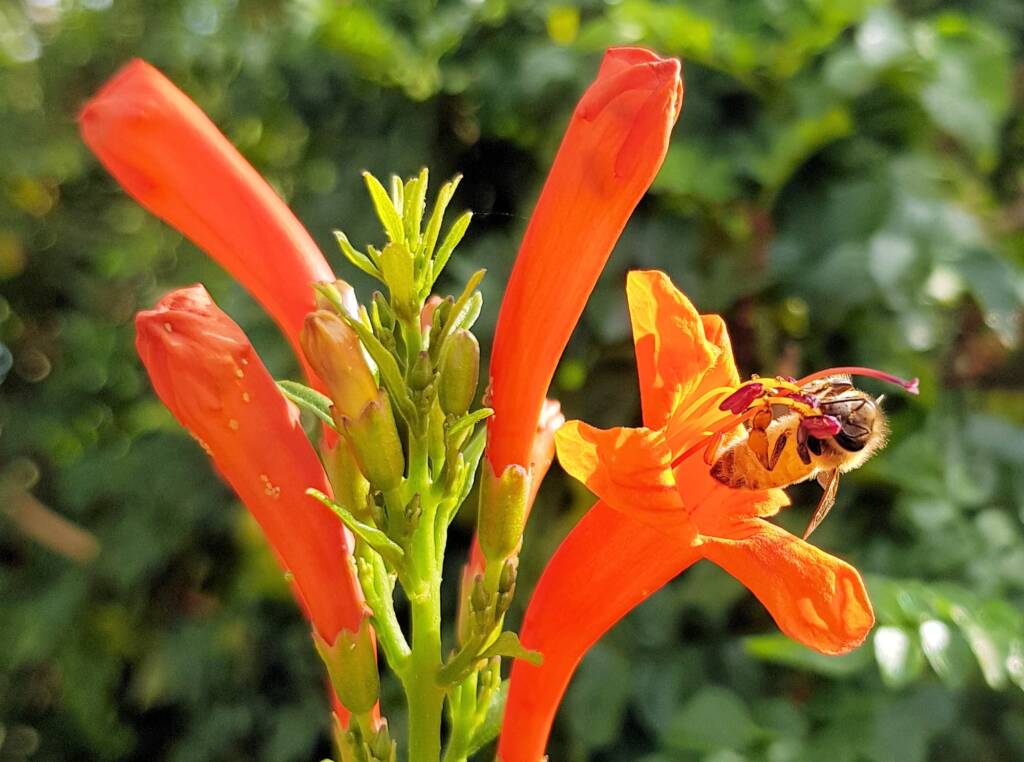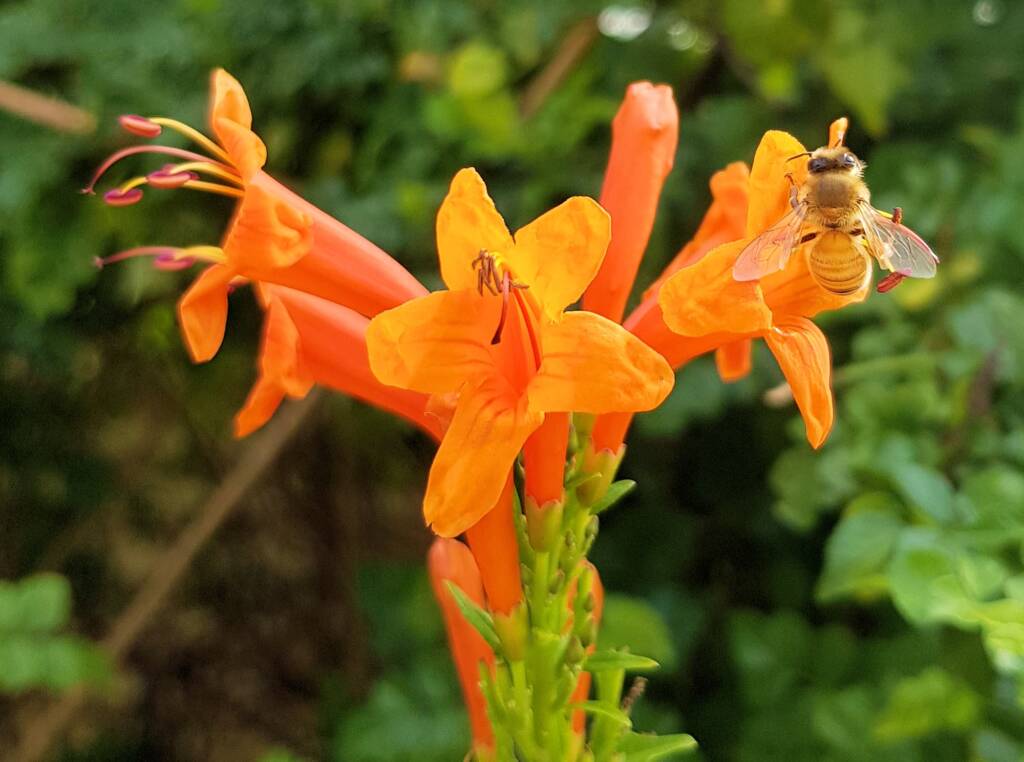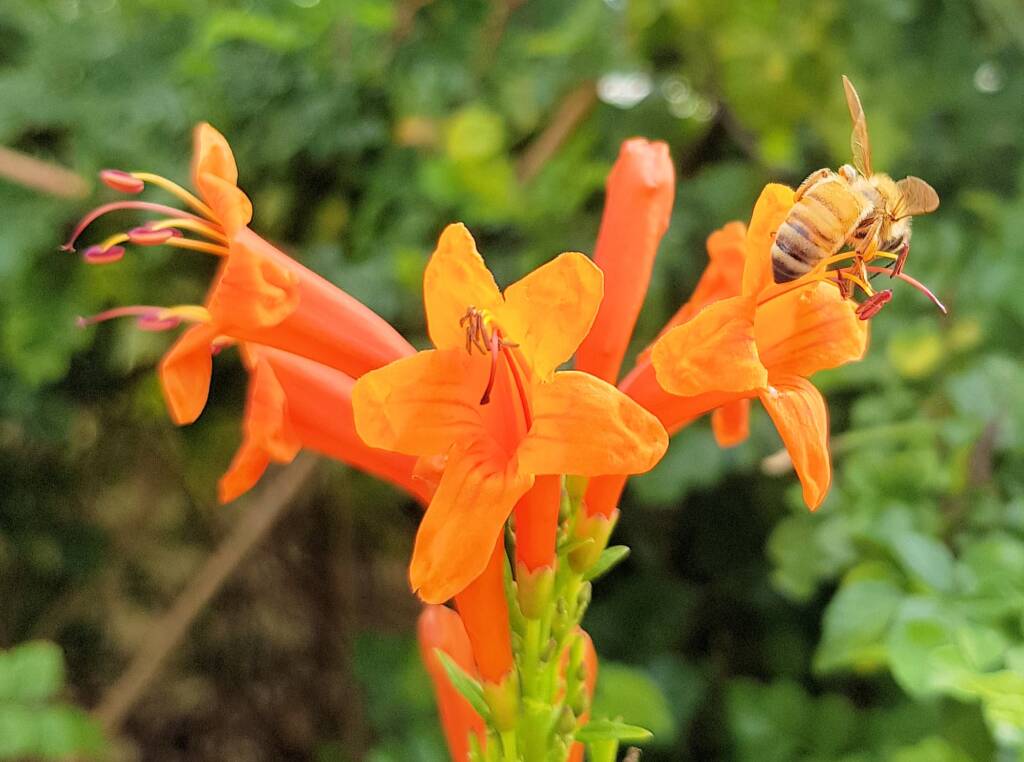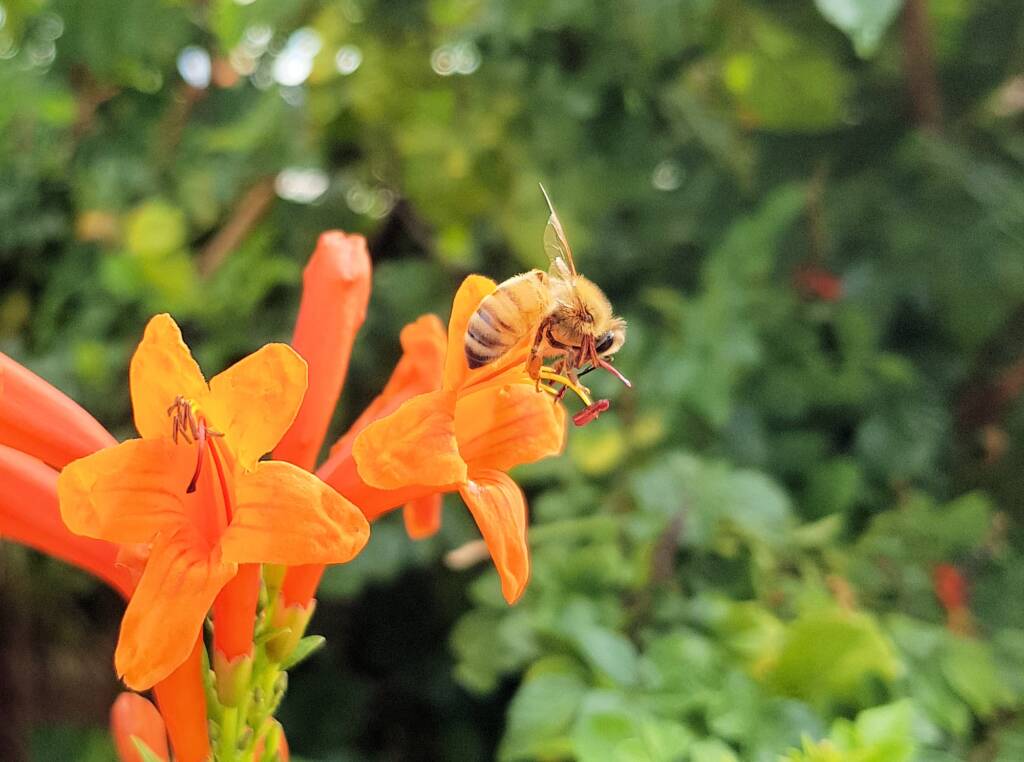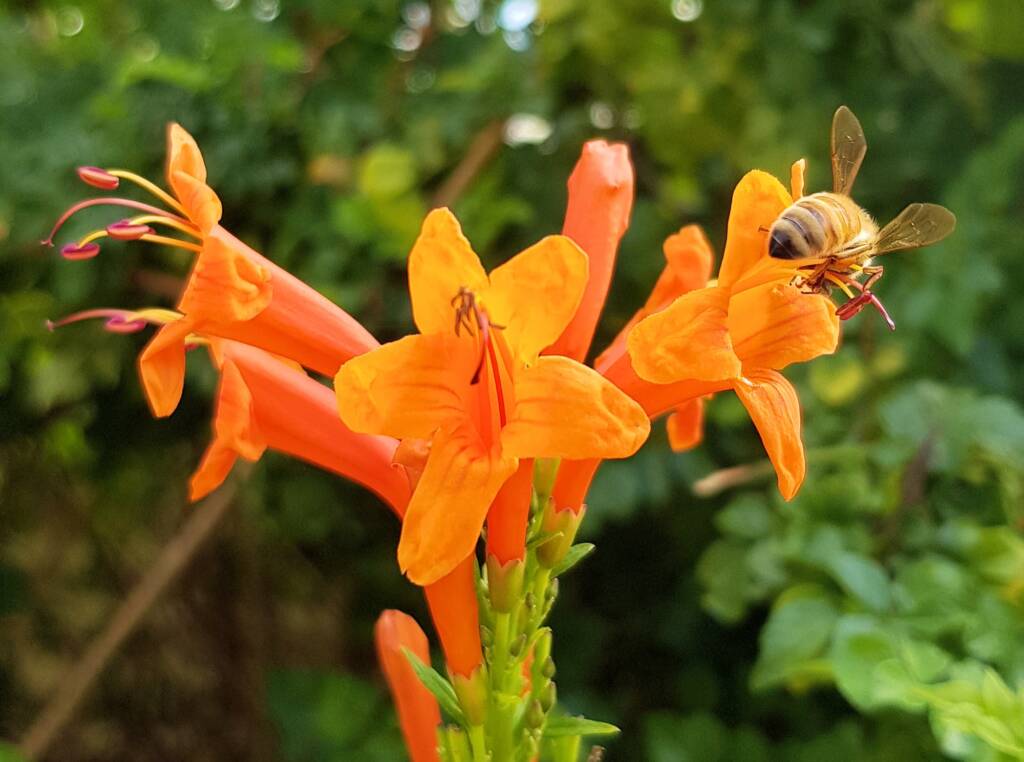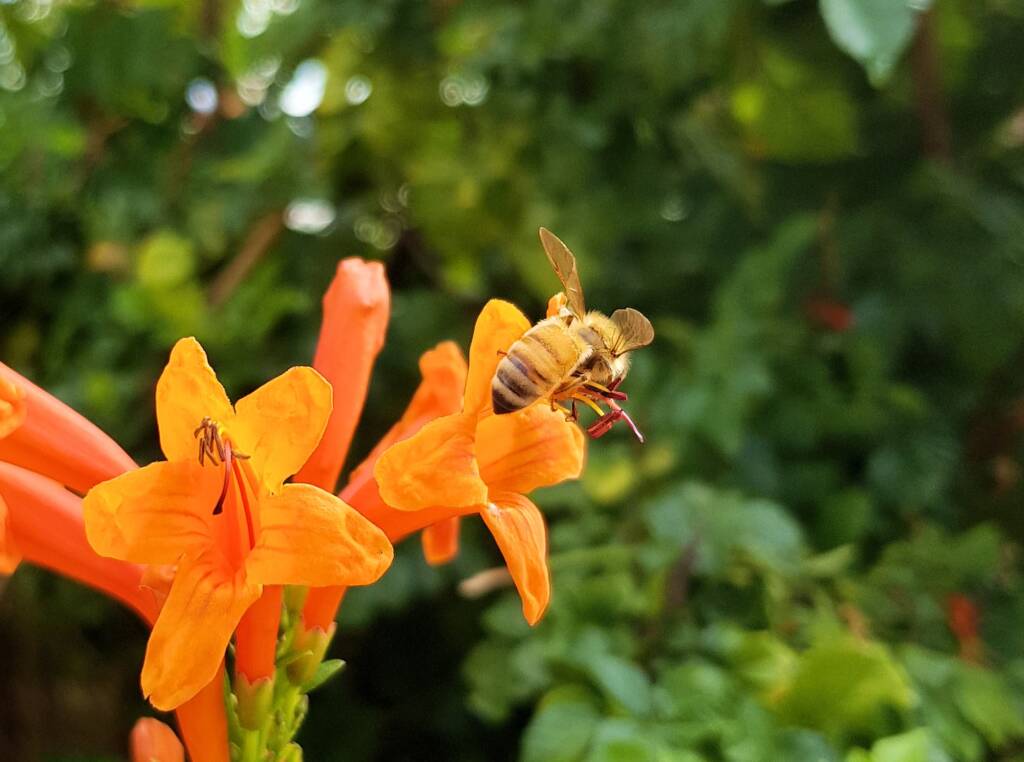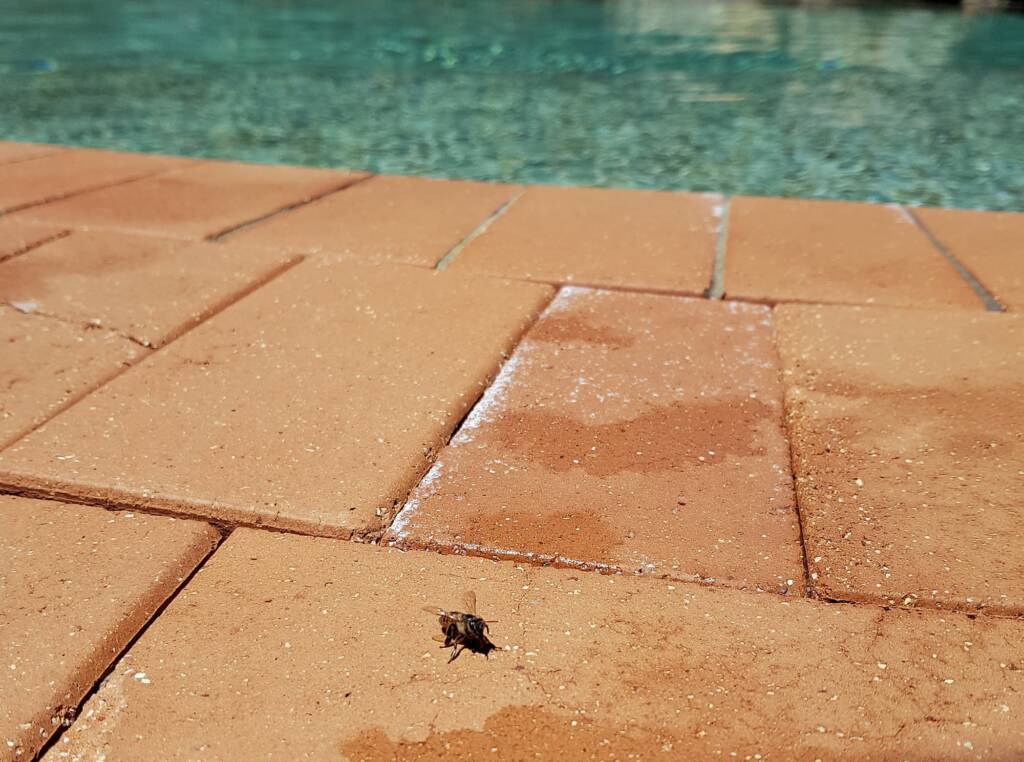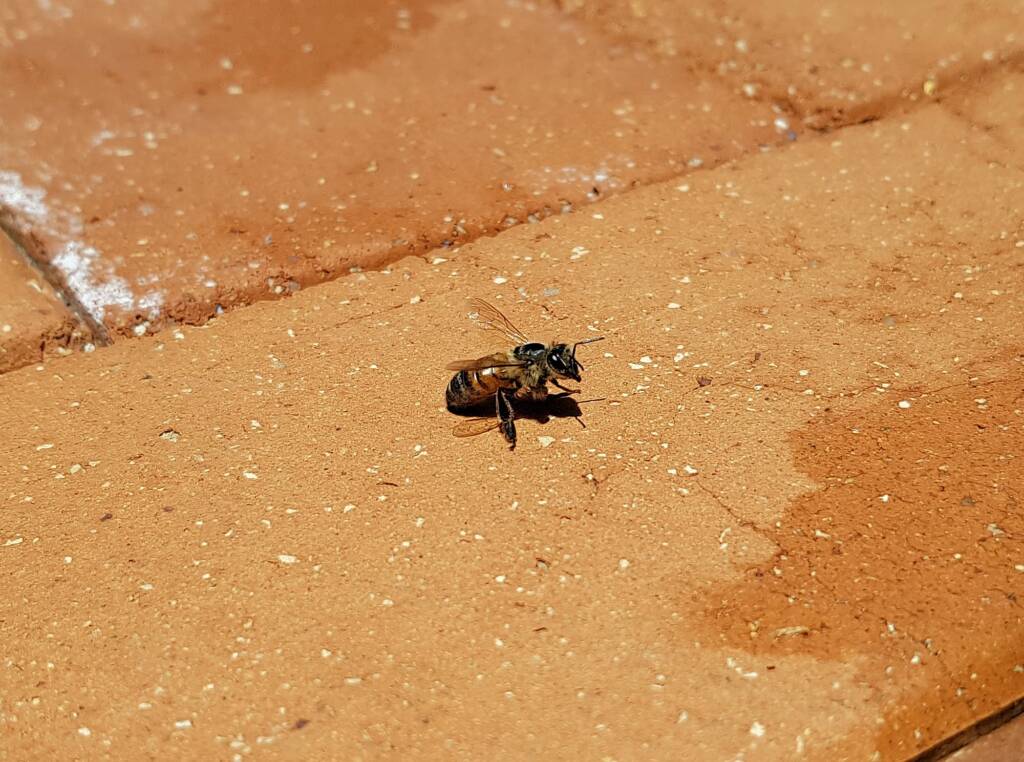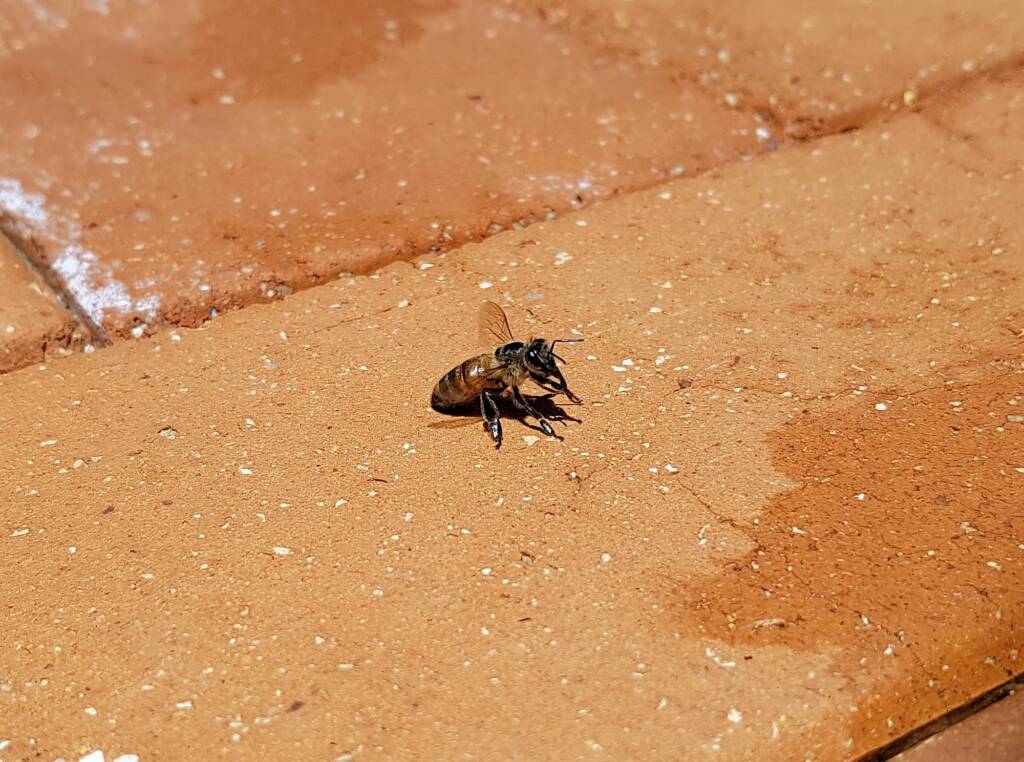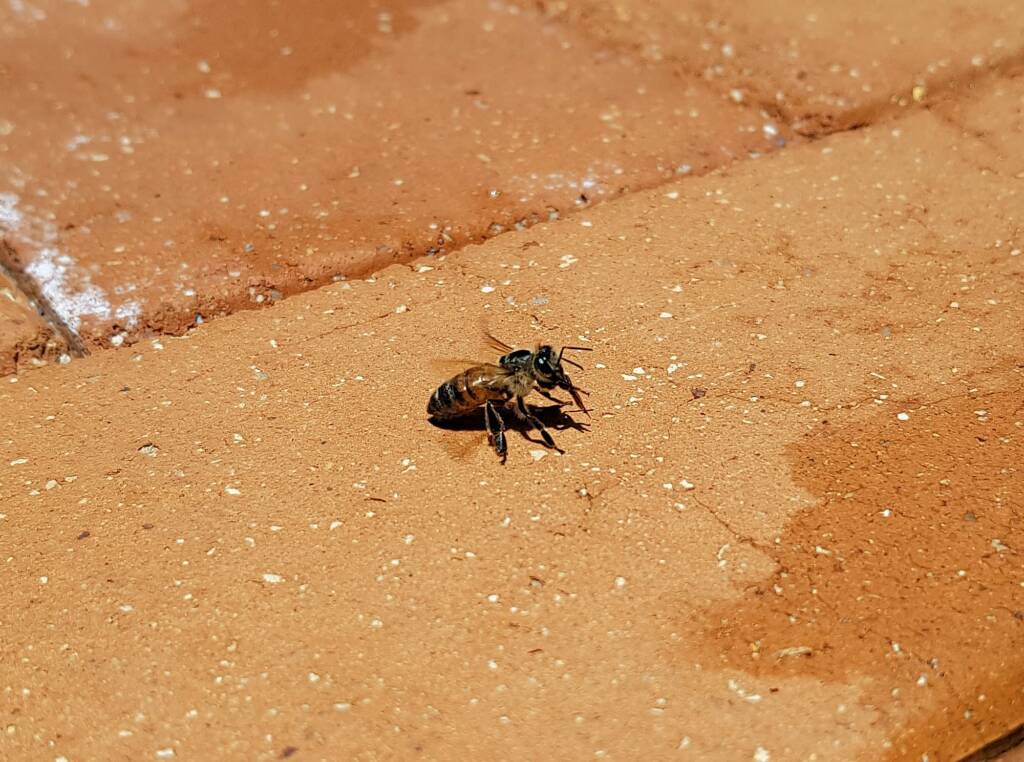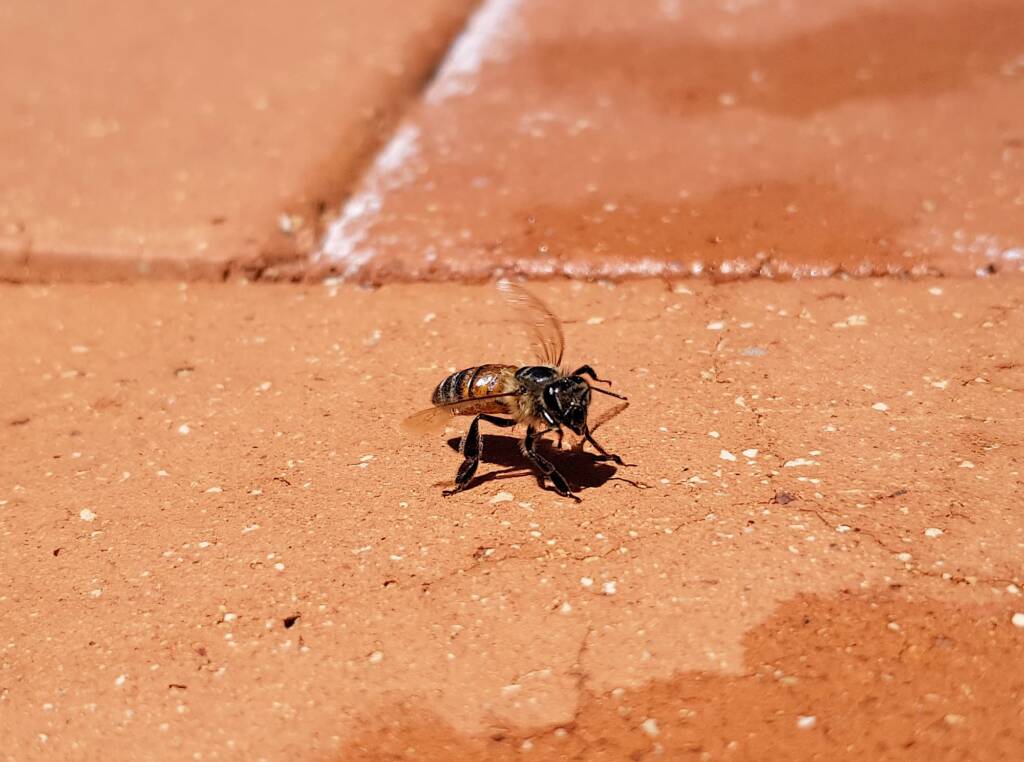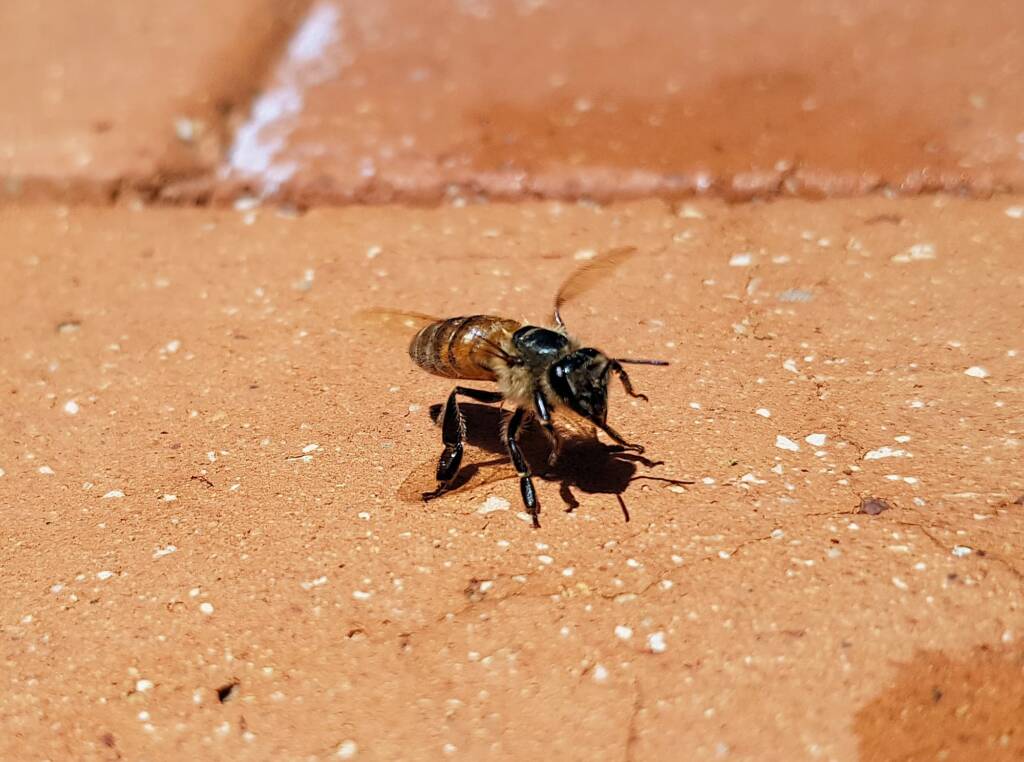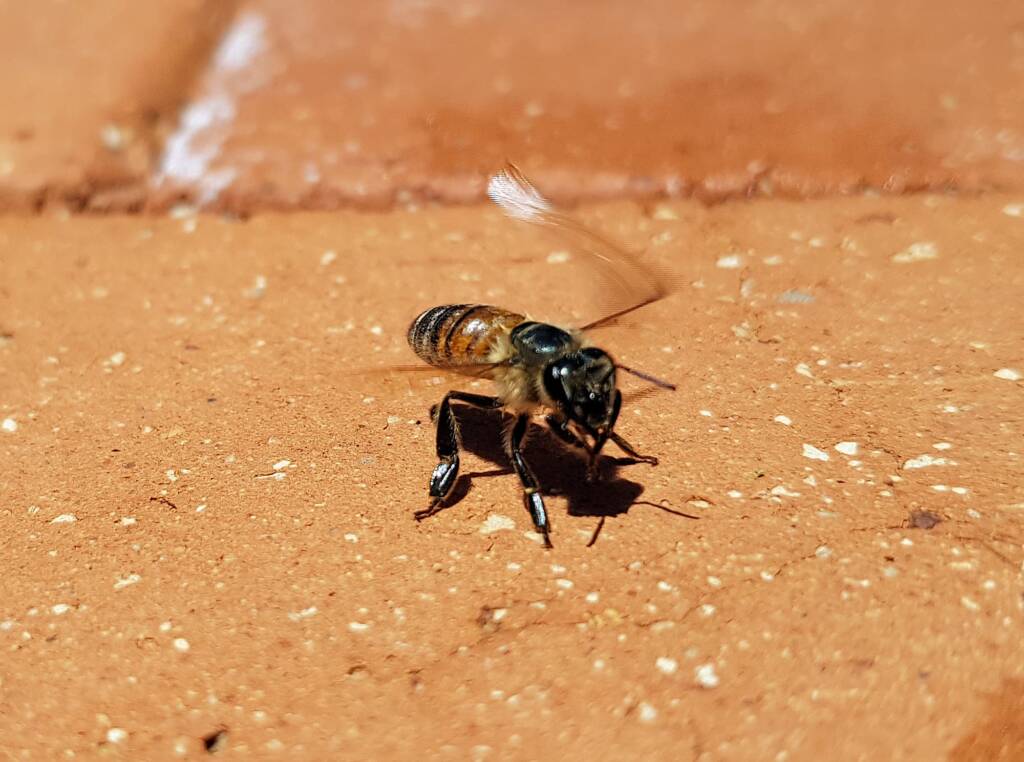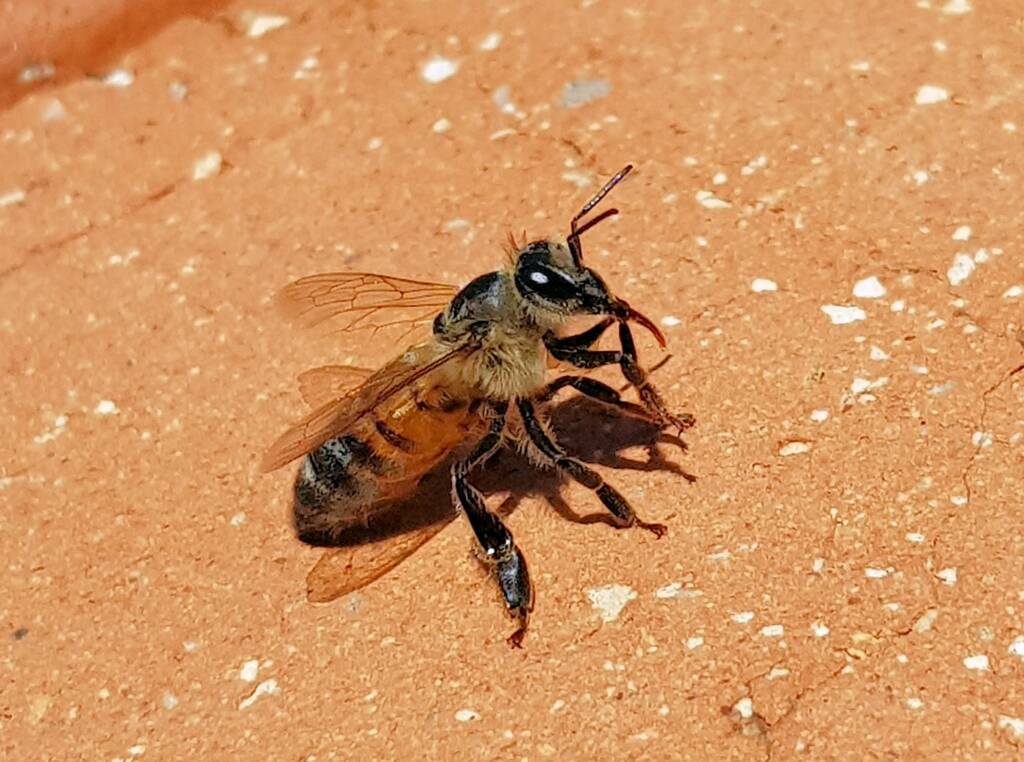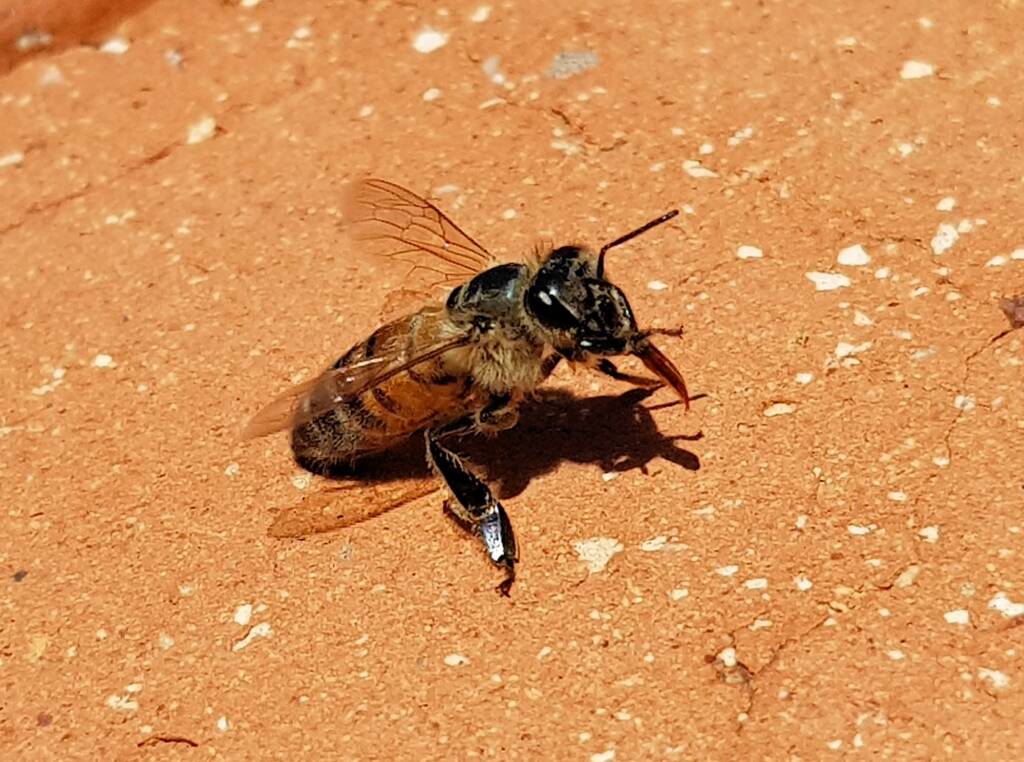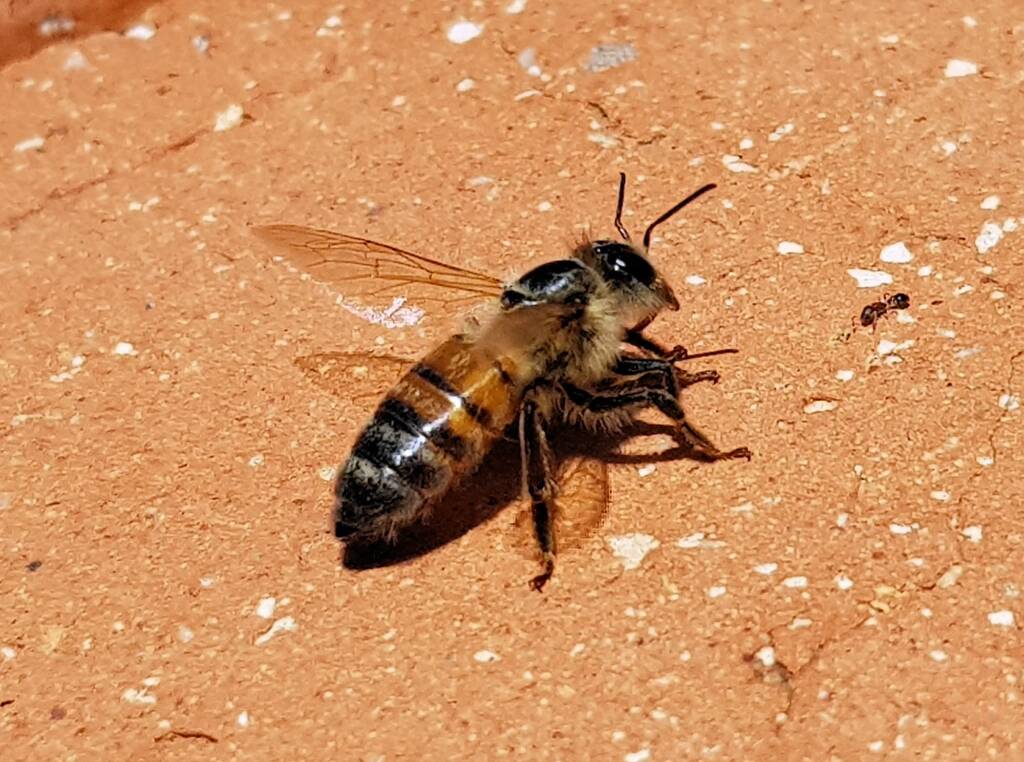Apis melliferaDark Apis mellifera Apis mellifera — Captured flora moments
The European Honey Bee (Apis mellifera), also known as the Western Honey Bee, is an introduced species to Australia and the most common of the 7-12 species of honey bees in the world. Currently there are recognised 32 subspecies (or races) of the species Apis mellifera. Like all the honey bee species, the European Honey Bee (Apis mellifera) is eusocial, creating colonies with a single fertile female (known as the queen bee).
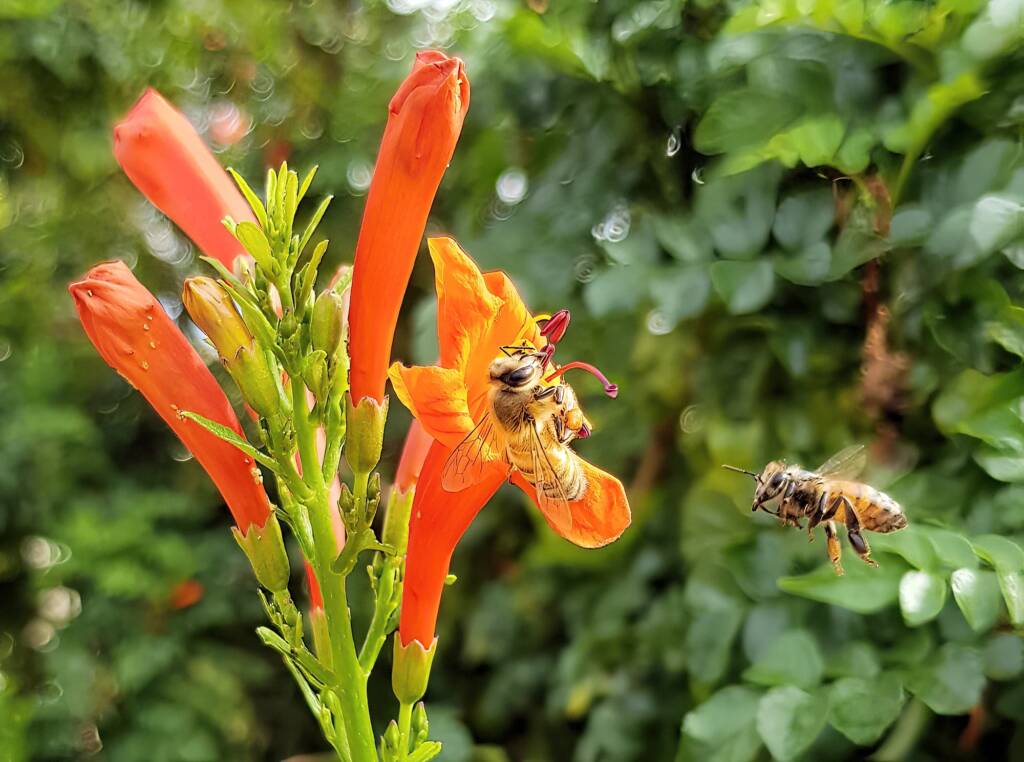
In a typical hive of Apis mellifera, there will be one queen, hundreds of drones, and thousands of worker bees. This caste-specific structure, also display a differences in longevity of each caste. At the top of the hierarchy is the Queen honey bee, whose life span is an average 1–2 years. On the other hand, the worker bees live on average 15–38 days during the summer and 150–200 days during the winter. The worker bees are all female. The drone bees are all male and as such, do not have a sting.
The European Honey Bee can range in size from 13-16 mm and are recognised by the yellow and black abdominal banding and fine visible hairs all over the body. Hairs even extend to around their eyes. The abdominal banding can vary in colouration and the patterns can differ slightly, with some banding being darker and some with more of a mix between darker and lighter banding patterns. Their antennae are slightly longer than their head and they have light brown to transparent wings with dark veins. The “worker bees” can sometimes look different as they age, losing their body hairs (most likely worn away) and giving them a darker appearance. Certainly, feral honey bees can be slightly different in colour.

Introduced to Australia by the early European settlers and colonists (thought to be around 1822), the European Honey Bee was used for honey production and used to pollinate plants that was grown by early settlers for food. Today in Australia, they are managed by apiarists in hives. The European Honey Bees have however managed to swarm and escape into bushland, where they have established feral nests. They have now occupied areas across Australia, including the semi-arid regions, eucalypt and rainforests, coastal heaths, farming and grazing land and urban areas. They become a nuisance during summer months when they seek water for themselves and to cool their hive.
Some of the images displayed on this page are of the European Honey Bee (Apis mellifera) collecting pollen from the flowers of another introduced species, the invasive flora Cape Honeysuckle (Tecoma capensis).
The impact of these feral bees on our native species is a controversial issue and difficult to quantify. With increase interest in our native species, and the growing activities by members of various bee groups and forums, as well as the encouragement of people to provide appropriate nesting environments for our native bees, it is hope that seeing a native bee in your garden and bushland will be a common thing.
The European Honey Bee require water, especially in the height of summer, when temperatures are soaring. They require water not only for themselves but to take back to the hive. They use water to regulate the temperature of the hive, feed young bees, and dilute stored honey.
It is at these times that the bee may drown whilst trying to collect water, and a reason you often find bees floating around in swimming pools when no other water sources are available.

Atlas of Living Australia
- Scientific classification
- Kingdom: Animalia
- Phylum: Arthropoda
- Subphylum: Hexapoda
- Class: Insecta
- Informal: Pterygotes
- Order: Hymenoptera
- Superfamily: Apoidea
- Informal: Apiformes
- Family: Apidae
- Tribe: Apini
- Genus: Apis
- Subgenus: Apis (Apis)
- Species: Apis mellifera
Source: Atlas of Living Australia5
iNaturalistAU
- Scientific classification
- Kingdom: Animalia
- Phylum: Arthropoda
- Subphylum: Hexapoda
- Class: Insecta
- Subclass: Pterygota
- Order: Hymenoptera
- Suborder: Apocrita
- Infraorder: Aculeata
- Superfamily: Apoidea
- Epifamily: Anthophila
- Family: Apidae
- Subfamily: Apinae
- Tribe: Apini
- Genus: Apis
- Subgenus: Apis (Apis)
- Species: Apis mellifera
- Subspecies:
- Apis mellifera ssp. Adami (Crete Honey Bee)
- Apis mellifera ssp. Adansoni (West African Honey Bee)
- Apis mellifera ssp. Anatoliaca (Anatolian Honey Bee)
- Apis mellifera ssp. Artemisia (Russian Steppe Honey Bee)
- Apis mellifera ssp. Capensis (Cape Honey Bee)
- Apis mellifera ssp. Carnica (Carnolian Honey Bee)
- Apis mellifera ssp. Caucasia (Caucasian Honey Bee)
- Apis mellifera ssp. Cecropia (Greek Honey Bee)
- Apis mellifera ssp. Cypria (Cyprian Honey Bee)
- Apis mellifera ssp. Iberiensis (Iberian Honey Bee)
- Apis mellifera ssp. Intermissa (Tellian Honey Bee)
- Apis mellifera ssp. Jemenitica (Arabian Honey Bee)
- Apis mellifera ssp. Lamarckii (Egyptian Honey Bee)
- Apis mellifera ssp. Ligustica (Ligurian Honey Bee)
- Apis mellifera ssp. Litorea (East African Honey Bee)
- Apis mellifera ssp. Macedonica (Macedonian Honey Bee)
- Apis mellifera ssp. madaros
- Apis mellifera ssp. Meda (Median Honey Bee)
- Apis mellifera ssp. Mellifera (British Black Honey Bee)
- Apis mellifera ssp. Monticola (East African Mountain Honey Bee)
- Apis mellifera ssp. Pomonella (Tien Shan Honey Bee)
- Apis mellifera ssp. Remipes (Armenian Honey Bee)
- Apis mellifera ssp. Ruttneri (Maltese Honey Bee)
- Apis mellifera ssp. Sahariensis (Saharan Honey Bee)
- Apis mellifera ssp. Scutellata (African Honey Bee)
- Apis mellifera ssp. Siciliana (Sicilian Honey Bee)
- Apis mellifera ssp. Simensis (Ethiopian Mountain Honey Bee)
- Apis mellifera ssp. Sinisxinyuan (Xinyuan Honey Bee)
- Apis mellifera ssp. Sossimai (Ukrainian Honey Bee)
- Apis mellifera ssp. Syriaca (Syrian Honey Bee)
- Apis mellifera ssp. Taurica (Crimean Honey Bee)
- Apis mellifera ssp. Unicolor (Malagasy Honey Bee)
Source: iNaturalistAU6
Footnote & References
- Western honey bee, https://en.wikipedia.org/wiki/Western_honey_bee (last visited Nov. 16, 2021).
- Honey Bee, Australian Museum, https://australian.museum/learn/animals/insects/honey-bee/
- Feral European Bees, Western Australian Museum, https://museum.wa.gov.au/explore/online-exhibitions/cockatoo-care/feral-bees
- Introduced Species of Bees in Australia, Aussie Bee, https://www.aussiebee.com.au/feral-bees.html
- Apis (Apis) mellifera Linnaeus, 1758, Atlas of Living Australia, https://bie.ala.org.au/species/https://biodiversity.org.au/afd/taxa/1a490f00-368f-427c-8d4c-fa3f3271d75f
- European Honey Bee (Apis mellifera), iNaturalistAU, https://inaturalist.ala.org.au/taxa/47219-Apis-mellifera
- Apis mellifera, honey bee, Animal Diversity Web (ADW), https://animaldiversity.org/accounts/Apis_mellifera/
- European honey bee, Apis mellifera and subspecies Linnaeus (Insecta: Hymenoptera: Apidae), Entomology & Nematology, Featured Creatures, University of Florida, https://entnemdept.ufl.edu/creatures/misc/BEES/euro_honey_bee.htm
Apis melliferaDark Apis mellifera Apis mellifera — Captured flora moments
BeesBees Anatomy Bee Behaviour Blogging Bees… Bees – image index Amegilla Bee Apis mellifera Austroplebeia australis Austrothurgus Braunsapis sp Ceylalictus perditellus Colletidae Euryglossinae Exoneura Homalictus Hyleoides bivulnerata Lasioglossum Lasioglossum (Chilalictus) Lipotriches Megachile Meroglossa Stenotritidae Tetragonula Thyreus Xylocopa

